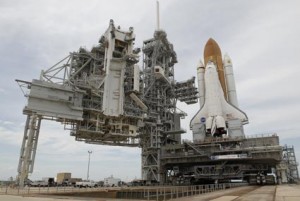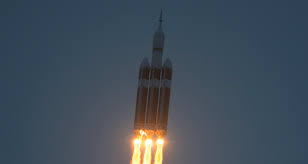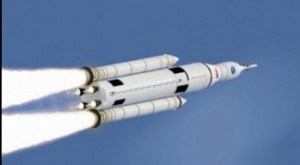
Space, the final frontier…
 It’s flashback time! This article appeared on my earlier website. I have updated some of the content.
It’s flashback time! This article appeared on my earlier website. I have updated some of the content.
One of my earliest memories was from the Summer of 1969, when I was just over two years old. I was in the living room of a tiny apartment in Cortland, New York, with my parents, watching Neil Armstrong and Edwin “Buzz” Aldrin Jr. take the first human steps on the moon. I remember the television picture being fuzzy, the sound being choppy, and (given my tender age) having absolutely no idea what was going on. All I could see was two guys in funny white suits climbing down a strange ladder, and walking and jumping around on some dusty field in the middle of the night. But my parents sat me down in front of the TV anyway, because they wanted me to be able to say that I watched the first manned landing on the moon.
I wasn’t old enough to understand that I was watching something happen 250,000 miles away. That dusty field was the Sea of Tranquility, and those two guys in funny white suits were the first humans to ever walk on the moon, something that until that day had been the stuff of science fiction stories. Some day, my parents thought, I would understand. They were right.
Today I am a supporter of space exploration, both manned and unmanned. Traveling to other worlds can fire the imagination. I believe that one day humanity will travel between the planets with ease. Some day we may even be able to travel between the stars. Space exploration has proven itself as a forum for scientific growth. It can also fuel the inherent human need for adventure, and the need to go a little further. On a more practical note, space exploration can also provide a means of economic growth. Hundreds of consumer products have been derived from space technology, while the moon, planets, and asteroids may hold enough mineral wealth to satisfy even the most ambitious mining tycoon.
There is literally a universe of possibility up there. So, what are we waiting for?
A lot of things.

I may be a supporter of space exploration, but my view on the matter is rather jaded. Space exploration is very expensive, and exceedingly dangerous. For proof of the former, just look at the budget sheet for the International Space Station. For proof of the later, just ask family members of the Challenger, Columbia, Apollo 1, or Salyut 1 crews.


- The first thing we need is better budgeting. The International Space Station programs is riddled with pork-barrel funding practices that cause them to go over budget: Way over budget, as in 130 percent and rising. The Space Shuttle was even worse, and according to some sources, was a money pit from the very start. Obviously this sort of thing can’t continue, but the institutional inertia of NASA and it’s counterparts around the world make reforms very difficult to implement. To make matters worse, a lot of these large cost overruns are tied to inefficient and often unreliable technology. The continued use of this technology stems from political concerns, not technical or scientific ones. Which brings me to…
- A change in the political climate. Did you know that NASA wanted to phase out the Space Shuttle in the mid 1990’s, and replace it with a more modern vehicle? The Space Shuttle was very expensive and inefficient to operate. Each launch cost about $500 million, which is much higher than the original design specifications predicted. NASA, wanting a more efficient budget (see above), wanted to introduce a launch system that was less expensive (same results for less cost) and/or more efficient (same cost with better results). Numerous projects were proposed, and many of them have had very innovative ideas. Considerable research has been put into the development of new launch vehicles, but none of them have come through. There was a strong lobby to keep the shuttle running simply because it is so expensive. A lot of people made a lot of money running the space shuttle, and they did everything they could to keep it flying, no matter what. Many astronauts called the Columbia-class space shuttle The Flying Brick. It was also a flying pork barrel, and that’s where the political climate has to change. Pork barrel projects are, sadly, part of most government operations. Once they are in place, they are very difficult to uproot, and even more difficult to stop. A decision was made in 2009 to end the space shuttle program, and even so it took another three years for it to finally wind down. Is the new Orion system an improvement? That remains to be seen, but if history is anything to go by, I suspect Orion will have some of the same institutional disorders as its predecessor.
- A change in how people view space exploration.“Space exploration is fine, so long as I don’t have to pay for it!” This is probably the most difficult problem facing space exploration today. Simply put, the average American doesn’t want a single penny of their tax money going to space exploration, and it’s not hard to understand why. From the perspective of the average guy-on-the-street, the space program hasn’t done anything practical or even interesting since the Apollo program put Americans on the moon, brought back moon rocks, converted them into rotten eggs, and hurled them at the Soviets. For most people, the most newsworthy thing the Space Shuttles ever did was blow up. (That isn’t true by any stretch, but the court of public opinion is very fickle, and it’s the two accidents that stick it people’s memories.) Add to this an ongoing series of budget problems, revelations of mismanagement by NASA program directors and contractors, a national space agency riddled with bureaucratic inertia, and crossed political motives at every step of the game. The end result should come as no surprise: the average American doesn’t give a damn about space exploration. The average American has more immediate concerns, like the lingering threat of another September Eleventh, the possible use of nuclear or chemical weapons in the Middle East, the unstable tightrope that is holding the world’s economy, the disturbing surge of reckless American adventuring in foreign affairs, putting food on the table, keeping a roof over their heads, and keeping clothing on their backs. When stacked against the queue of social, political and economic issues that are facing the world right now, something as seemingly frivolous and trivial as space exploration doesn’t even place.
I can’t speak for the citizens of the European Union, Japan, or Russia, but I’m willing to bet that they have similar feelings on this matter.
Many folks like to talk about the possibilities of space travel, but when it comes time to allocate funds or other resources to it, they start backpedaling. A lot of space activists try to bring space exploration to the forefront of the national agenda. Based on what I’ve observed in the political hotbed of Washington, DC, that will never happen. Furthermore, NASA and the rest of the national space agencies, collectively, have very poor publicity departments. If they could do some decent marketing, and show the general public how space exploration really can benefit the average person on the street, public opinion might begin to change.
If humanity is ever to move beyond this rock, all of this will somehow have to change.
These situations tend to feed one another, which makes finding solutions even more difficult. There are many very effective arguments that demonstrate how space exploration can help solve the problems facing the world today, and speaking only for myself, I think that’s true. World hunger, poverty, stagnation in technology, economic imbalances, and shortfalls of useable resources, can all be alleviated, perhaps even solved, by the various resources that are available in space. Space farms, space cities, factories on the moon, and mining the asteroid field, to name a few, could all help alleviate problems that currently exist on Earth. However, most of those solutions require a fairly extensive space-based infrastructure, far beyond anything that any government program is planning at present. The International Space Station doesn’t even scratch the surface of what would be needed, and may in fact be a detriment.
If the space development programs of the 1970’s had been allowed to continue, then the needed infrastructure to exploit space would largely be in place by now, and the options of using space to help conditions on Earth would be available today. But, those projects did not continue, and the infrastructure does not exist. Building such an infrastructure would require a lot of work, time, and resources to implement. The results would be spectacular and ultimately beneficial to everyone on earth, but it won’t happen overnight, and the up-front costs will be very high. Selling this to a skeptical public would prove very difficult, and given the current global situation, is probably impossible.
For every compelling argument in favor of space development there is an equal and often more compelling argument against it, and for a long time those arguments tended to win (and they may still be). The current system of space development relies on government co-operation, and during the last three decades, governments all over the world have become preoccupied with other, more urgent and more immediate sociopolitical concerns. These concerns are likely to keep the world’s political machines occupied indefinitely. They don’t have the time or the resources to truly explore and develop space, and it would probably require a Lucifer’s Hammer scenario to change that. There are some situations where a government run agency is the only entity large enough to handle the logistics of a major space mission (a mission to Mars, for example), but they are not the answer to everything. And for many they shouldn’t be the first choice.
Currently, one of the best options for space development lies with individuals, and groups of individuals, who have taken matters into their own hands. Scaled Composites, a private aerospace firm, recently developed a prototype rocket plane called Space Ship One. This rocket plane is launched from a special high altitude airplane called The White Knight. The idea is a simple one that dates back to the 1950’s: the airplane carries the space capsule to a high altitude and releases it, where the rocket engines on the capsule push it into a suborbital trajectory. Many of the early X projects, like the X-15, used a system like this. The Pegasus XL booster, a small, unmanned payload carrier widely used by the Navy and Air Force, uses a variation of this concept. Even the original designs of the Space Shuttle used a system like this!

Burt Rutan, the chief executive officer of Scaled Composites, first gained media attention with his Voyager airplane, which circumnavigated the globe on one tank of fuel. He also worked with NASA (and its contractors) on several projects, including the construction of new launch vehicles. It was the continual cancellation of these projects that inspired his company to “go solo” and develop the White Knight. Scaled Composites plans to initiate a non-government funded, manned space program for the private sector. On June 21 of 2004, White Knight and Space Ship One successfully carried a man into space, and less than two weeks later, won the X-Prize.

Since the testing of Space Ship One, we have seen the development of the Space-X Dragon shuttle. This semi-reusable capsule has successfully been used by several clients, including NASA, to bring small payloads to and from space. In theory, Dragon can carry both cargo and passengers if needed. But to my knowledge, it has only been used to carry cargo. There was talk of equipping a Dragon to serve as a rescue vehicle for the International Space Station, should the need arise. Research and development continues on this idea.
On a related front, hotel tycoon Robert Bigelow offered a large monetary prize to the first firm that could loft a privately produced and financed orbital platform. His target market is space tourism, which could become a very lucrative market if any of the X-Prize projects are successful. I don’t know if Bigelow’s prize was ever claimed, or by whom. But if his challenge ultimately resulted in an orbiting space hotel, then further space development shouldn’t be far behind. Many agree that the largest obstacles to space development are 1) finding a reliable and relatively inexpensive to reach orbit, and 2) making it possible for people to live and work in space for long periods of time. Space tourism may be able to overcome both of these obstacles.
Burt Rutan is an example of an individual who has taken the matter of space development into his own hands. He drew up a workable plan of action, and is following through on it, without relying on NASA or ESA. Robert Bigelow’s challenge should encourage others to follow Rutan’s example, and come up with new plans to reach further and higher. If enough of these private programs succeed, then public opinion about space exploration may begin to improve. When that happens, the cycle I described above should start to break down. It is unlikely that any private organization, or even a group of organizations, will ever be able to attempt something as massive as an interplanetary mission or a large-scale space habitat. Projects on that scale will still require several governments working in tandem. Right now, that isn’t likely to happen. But if private industry is able to change the public perception of space development, then one day, perhaps it will happen.
Now that I’m (mostly) finished ranting, here are some space exploration links.
National Space Agencies
- United States National Aeronautics and Space Administration
The people that brought us Mercury, Gemini, Apollo, Skylab, the Space Shuttle… and enough bureaucracy to choke even the most experienced clerical staff.
- Russian Space Agency
These guys started the whole thing with Sputnik, though back then they were called the Soviet Space Agency. They are still active today, when they have the funds.
- European Space Agency
This international conglomerate is currently very active and can do some great stuff, so long as their contractors aren’t fighting among themselves.
- NASDA
The national space program of Japan. These folks are partners in the International Space Station project, and a popular target for industrial espionage.
Companies (Beware of web rot.)
- Space-X.
Builders of the Dragon Shuttle.
- S.P. Korolev Rocket & Space Corporation Energia
These folks have been building rockets for the Russian space program since the days of Sputnik.
- Molniya.
These guys built the Soviet orbiter, Buran, and are still active in developing aerospace technology.
- Scaled Composites (the White Knight group)
This company is attempting to initiate a non-government funded manned space program, and based on the results of their prototype vehicle, they have a good chance of succeeding!
- LiftPort Group
These guys are trying to build a space elevator. That’s right, a Space Elevator. Talk about reaching for the top…
Resources for News
In addition to news that can be found at company and agency web sites, these sites provide space related news in nice, easy payloads.
- SpaceToday
This is a good, clearinghouse site with a variety of links.
- Universe Today
This is also a good, general site, but it also has articles and editorials.
- Space Daily
This is a popular online newspaper for space travel fans, and my personal favorite. It has a lot of good stuff, though some of their columnists and commentators tend to be overly focused. At the same time though, some of their columnists are good at cutting right to the chase and pointing out what’s wrong with the current space programs. And they do so with the subtlety and finesse of a solid rocket booster.
Organizations
Before you start browsing these sites, be warned: a lot of people in the space community are obsessed, and their web sites reflect that. Don’t be surprised if these sites are filled with fiery (and impractical) rhetoric, coupled with apocalyptic predictions. They may have good ideas, but they tend to be full of themselves. Look at their ideas and dreams, but don’t send them any of your money, and take what they say with a grain of salt.
For an explanation of why I recommend guarding your wallet, I suggest two articles by John Carter McKnight, which appeared in SpaceDaily: The Blue Pill Choice, and Smells Like Teen Spirit. McKnight explains the frivolity of their views far better than I ever could.
As a closing note, I mentioned that one of my earliest memories is of the first moon landing, which happened near the beginning of my life. I used to dream that before the end of my life I would see a human walking on Mars. That isn’t likely to happen. There have been proposals for a manned mission to Mars since the mid 1980’s, but none of them have received serious attention. It will probably be a least a decade before the idea of even returning to the moon is taken seriously, never mind going to Mars. The timetable for the exploration of space will be measured in decades, perhaps even centuries.
Many of the people who currently advocate space exploration tend to want the future for themselves. They want to personally walk on other planets and see humanity reach for the stars. And they don’t want this to come about at some far away point in the future. They want this to happen today, or at least within the lifespan of the current generation. The cold truth of the matter is that the current generation isn’t likely to live long enough to realize these dreams. It’s possible that the current generation will see a human walk on Mars, and perhaps see manned missions to other planets in the solar system. But that’s about as far as we’ll get on a fifty-year timetable. The future they advocate belongs to the very young, and those who haven’t been born yet. For the current generation to try and seize the future would be exceedingly selfish; they aren’t going to live long enough to see it. But, to lay the groundwork for the future, and perhaps begin to build it, would be very noble.
I used to want the future for myself, but the future doesn’t belong to me. By the time a human walks on Mars, I fully expect to be well planted under six feet of soil. But perhaps my daughter or son, or one of their children, will watch a fuzzy broadcast of a man in a funny white suit walking around on a barren, dusty red field on the edge of Serina Planium. I’m going to try and do what I can to make sure they do see such a broadcast.
Even if they aren’t yet old enough to understand it.

This article is very dated now, and I have not yet written one to replace or supplement it. Commercial interests, such as the Dragon Shuttle, and the freshly-tested Orion capsule are starting to shift the public perception of space development. As such, I am actually less cynical on this issue today as I was when I first wrote my first draft of this in 2004.
- The alternate ISS at the top of the page was rendered using Skybase.
- The image of the Dragon is linked to the Space-X company web site.
- The images of the ISS, space shuttle, and Orion launch stack are from an assortment of NASA sources.






